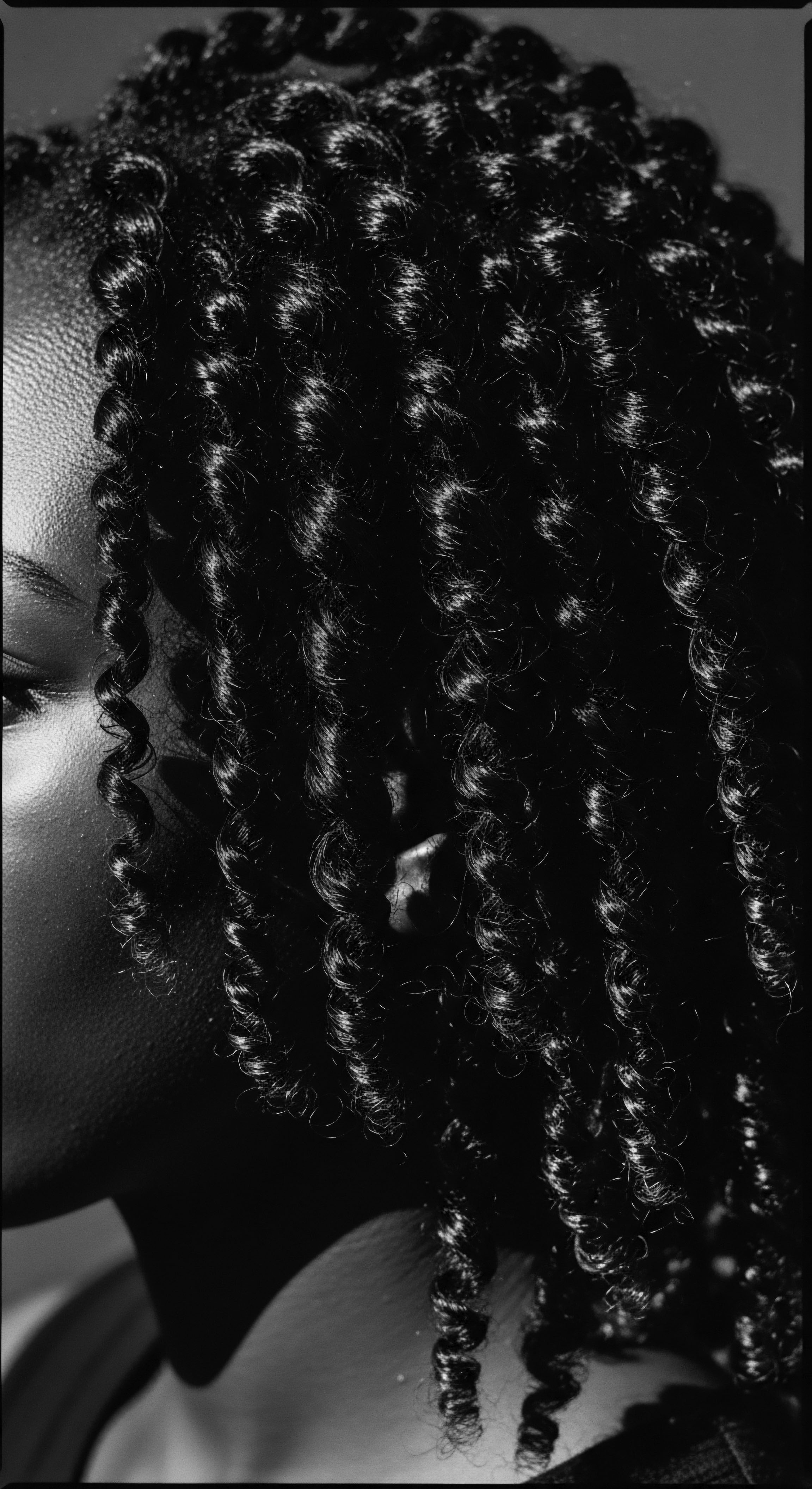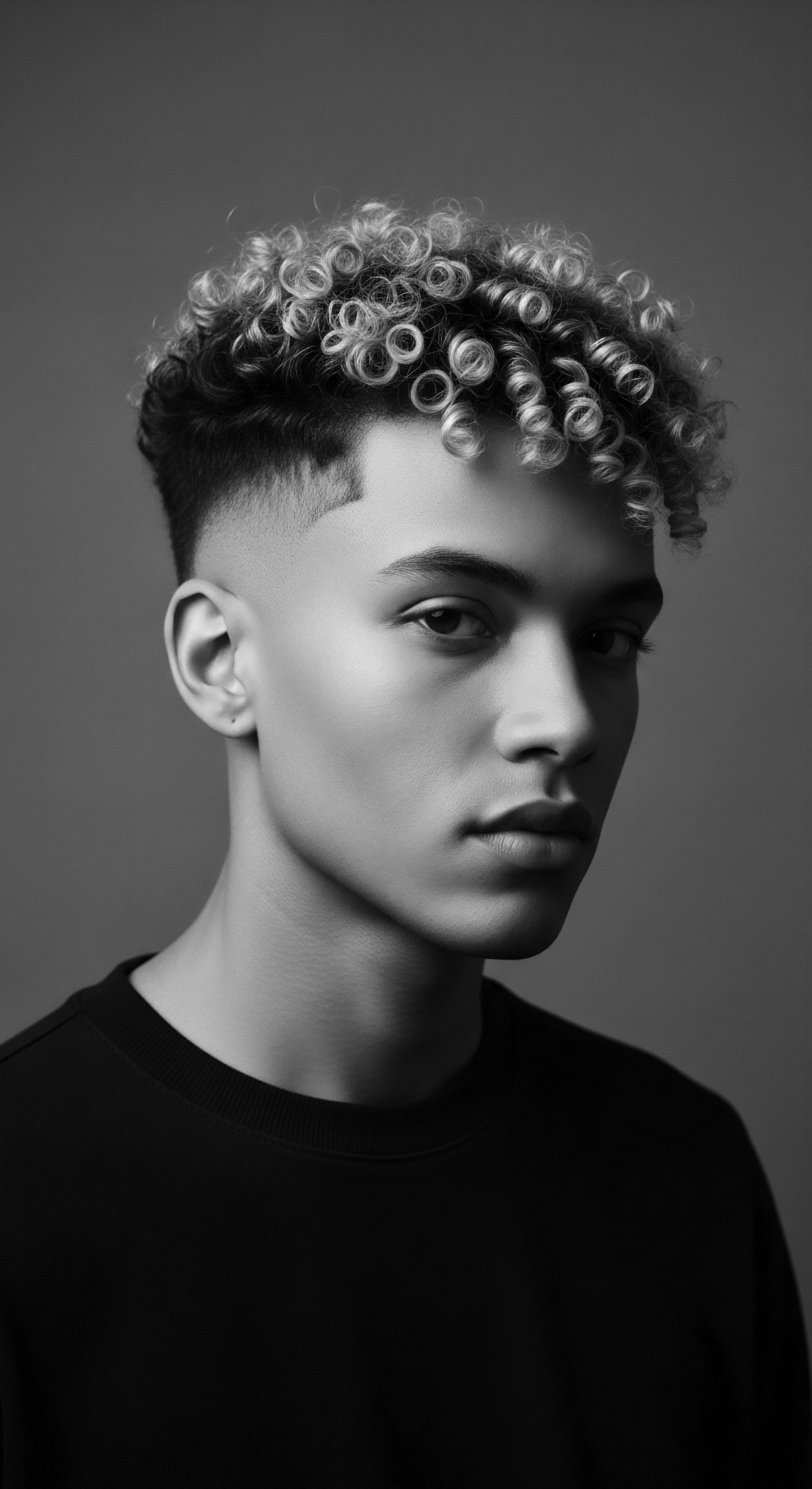
Roots
There exists, within the very fabric of our being, a memory etched in the curl, a story held within the strand. It speaks of ancestral lines, of sun-drenched earth, and the whispers of botanicals long revered. For those whose hair coils and bends with its own unique grace, the historical care it received was never a simple matter of cleansing or adornment.
It was, and remains, a sacred dialogue with the living world, a practice steeped in the profound wisdom of prior generations. The traditional plant preparations, once the sole source of hair health, are not just relics from bygone eras; they represent a deep, unbroken connection to heritage, a testament to human ingenuity and an abiding respect for nature’s provisions.
Consider, if you will, the intimate relationship between the structure of textured hair and the botanical world that met its needs. Each coil, each zig-zag, possesses a distinct anatomical profile, characterized by its elliptical cross-section and often fewer cuticle layers compared to straight hair. This structural reality, with its propensity for dryness and fragility, meant that traditional care practices centered on moisture, protection, and fortification.
Ancient communities recognized these inherent characteristics through observation and sustained generational knowledge, long before microscopes revealed cellular truths. Their solutions arrived from the earth, from leaves, barks, seeds, and fruits, each chosen for its particular sympathetic quality to the hair’s demands.

Hair Anatomy and Ancestral Wisdom
The journey into understanding textured hair’s historical care begins with a recognition of its intrinsic design. Unlike cylindrical strands, curly and coily hair often has an ovular or flat shape. This shape means that the natural oils produced by the scalp, known as sebum, struggle to travel down the hair shaft effectively. The external layer, the cuticle, which functions like protective shingles on a roof, can also lift more readily in textured hair, leaving the inner cortex vulnerable to moisture loss and environmental stressors.
Ancestral wisdom, passed down through observation and practice, found remedies in the plant kingdom to counteract these tendencies. They understood, intuitively, that moisture was paramount, and strength a constant pursuit.
These ancient caregivers didn’t label hair types by numerical systems. Instead, they observed the way hair behaved in various climates, how it responded to different treatments, and how it intertwined with daily life and ceremony. A deep understanding of the local flora allowed them to select specific plants that could address dryness, improve manageability, and offer a protective barrier against the elements. This was a living science, refined over countless cycles of growth and seasons, deeply rooted in the ecological landscapes of their communities.
The historical preservation of textured hair health is intricately bound to the intuitive scientific understanding embedded within ancestral plant practices.

Plants for Hair Protection and Growth
The historical lexicon surrounding textured hair care is rich with terms reflecting direct actions ❉ to soften, to strengthen, to cleanse without stripping, to adorn. These verbs directly correspond to the properties of the plant preparations used. Take, for instance, the term ‘oil,’ which often referred to a carefully rendered extract, or a ‘poultice,’ denoting a preparation applied for specific healing or conditioning.
The purpose was clear ❉ to maintain length, prevent breakage, and promote a healthy scalp. The very definition of hair health was tied to its ability to retain moisture and resist the rigors of daily life and harsh environments.
Hair growth cycles, though not understood in modern follicular biology terms, were certainly observed as periods of active growth and rest. Communities linked hair vitality to overall wellbeing, diet, and seasonal rhythms. Plants played a role in supporting these cycles. Ingredients were often selected not only for their direct effect on hair but also for their nutritional value, either applied topically or consumed, recognizing the deep connection between internal health and external radiance.
This integrated approach highlights a profound, holistic understanding of the human body and its relationship to the natural world. It was a symbiotic dance, where the earth offered its bounty, and human hands transformed it into care.
| Historical Period/Region Ancient Egypt |
| Key Plant Preparations Castor oil, Henna, Fenugreek, Aloe Vera |
| Primary Hair Benefit (Ancestral View) Moisture retention, strengthening, color enhancement, shine |
| Historical Period/Region West Africa (e.g. Sahel region) |
| Key Plant Preparations Shea butter, Chebe powder, African Black Soap |
| Primary Hair Benefit (Ancestral View) Deep conditioning, length retention, cleansing without stripping, protection from sun and wind |
| Historical Period/Region Ancient India (Ayurveda) |
| Key Plant Preparations Amla, Bhringraj, Hibiscus, Brahmi |
| Primary Hair Benefit (Ancestral View) Scalp health, hair growth stimulation, preventing hair fall, natural conditioning, premature gray prevention |
| Historical Period/Region These ancestral practices demonstrate a universal reliance on botanicals, tailored to specific hair needs and environmental conditions, upholding a legacy of natural care. |
The selection of specific plants often depended on regional availability and deep-seated cultural knowledge. In West Africa, for example, the widespread presence of the shea tree meant its butter became a foundational element of hair care. Its fatty acid composition offers profound moisturizing capabilities, an absolute boon for coils that thirst for hydration.
Similarly, in Chad, the Basara women turned to the Chebe plant, developing a unique powder to protect their hair. This reliance on local flora speaks volumes about adaptive intelligence and the wisdom of living in harmony with one’s surroundings.

Ritual
The care of textured hair, throughout history, was seldom a solitary task. It lived as a ritual, a communal gathering, a moment of intimate connection passed between generations. Plant preparations were not merely ingredients; they were the very conduits through which these practices were carried out, shaping the techniques, tools, and transformations that defined hair heritage.
Styling, then, was not simply about appearance; it spoke of identity, status, community bonds, and the deep roots of tradition. The tactile experience of applying these botanical preparations, the scents filling the air, the rhythmic movements of fingers through strands, all contributed to a profound, living tradition.

Ancestral Roots of Protective Styling?
Protective styling, a widely recognized method for safeguarding textured hair from manipulation and environmental damage, has ancestral roots stretching back millennia. Before the advent of synthetic fibers or chemical treatments, plant preparations were central to creating and maintaining styles that preserved hair length and health. Whether it was twisting, braiding, or coiling, these styles often involved the application of plant-based oils, butters, or pastes.
These ingredients provided the necessary slip for manipulation, imparted moisture, and sealed the cuticle, allowing styles to last longer and offer true protection. The purpose was pragmatic and deeply cultural ❉ to keep hair clean, neat, and thriving while minimizing breakage.
Consider the Basara women of Chad and their enduring practice with Chebe powder. For thousands of years, this tradition has been a cornerstone of their hair care, enabling them to achieve remarkable hair length, often reaching their knees. The powder, derived primarily from the Lavender Croton plant ( Croton gratissimus ), is mixed with oils or butters—like shea butter—to form a paste. This paste is applied to the hair, section by section, carefully worked into the strands but not directly onto the scalp.
The hair is then often braided, locking in the protective benefits of the Chebe. Anthropological studies, such as those documented by the University of Cairo, have observed how Chadian women maintain hair length despite arid desert conditions, a testament to Chebe’s efficacy. This practice highlights how plant preparations became the very foundation of styling techniques designed for preservation. The cultural context extends beyond individual beauty; these sessions are often communal, passed from mother to daughter, fostering intergenerational knowledge and strengthening social bonds.

Botanical Detanglers and Cleansers
Traditional care recognized that detangling was a particular challenge for textured hair. Plants with mucilaginous properties or natural saponins were prized for their ability to provide “slip,” making the process gentler and less damaging. One such example from Chad is Ambunu, leaves from the Ceratotheca sesamoides plant. When soaked in water, Ambunu leaves produce a slippery, gooey substance that acts as a natural detangler, conditioner, and even a mild cleanser.
This plant helps to loosen knots and tangles without stripping the hair of its natural moisture, a vital function for hair prone to dryness. It also contains saponins, which offer cleansing properties, making it a soap-free alternative that leaves hair refreshed and hydrated.
The practice of using African Black Soap also demonstrates a sophisticated understanding of plant-based cleansing. This soap, traditionally from West Africa, utilizes ingredients such as plantain skins, cocoa pods, and palm tree leaves, which are boiled to create ash. This ash is then combined with natural oils like Shea Butter and coconut oil. The result is a cleanser that is gentle yet effective, removing impurities without dehydrating the hair or scalp.
Its historical application spans centuries, serving as a staple in West African households for both skin and hair care. These natural cleansing agents allowed for regular hair maintenance while upholding the hair’s delicate moisture balance.
- Ambunu ❉ A plant from Chad known for its exceptional detangling properties due to its slippery mucilage.
- African Black Soap ❉ A traditional cleanser from West Africa, crafted from plantain ash and oils, offering gentle yet effective cleansing.
- Henna ❉ Used in ancient Egypt for coloring and conditioning, providing a reddish tint and strengthening hair.

Tools and Traditional Preparations
The tools employed in traditional hair care often worked in concert with plant preparations. From wide-toothed combs carved from wood to simple finger techniques, the aim was always gentle manipulation. The slip provided by plant oils and detanglers enabled the use of these tools without causing undue stress or breakage to textured strands. The crafting of these tools was often a skill passed down, just like the recipes for the preparations themselves, creating a complete ecosystem of care rooted in heritage.
Take, for instance, the preparation of traditional oils. The processing of Jamaican Black Castor Oil (JBCO) involves roasting and grinding castor beans, then boiling them to extract the oil. This traditional method, originating in Africa and carried to the Caribbean during the slave trade, yields a dark, thick oil renowned for its potential to support hair growth and strengthen strands. Its unique processing, which gives it its characteristic dark hue and higher ash content, distinguishes it from other castor oils and is believed to contribute to its effectiveness in nourishing hair follicles and promoting circulation in the scalp.

Relay
The echoes of ancestral wisdom reverberate across generations, shaping contemporary hair care regimens and offering profound solutions to modern challenges. Traditional plant preparations, far from being remnants of a distant past, hold a vital place in addressing the complex needs of textured hair today. They continue to inform holistic care, nighttime rituals, and targeted problem-solving, acting as a living bridge between historical practices and current understanding. This continuity speaks to an enduring heritage, a deep well of knowledge that continues to provide both efficacy and a profound sense of cultural connection.

Does Ancestral Wisdom Shape Modern Hair Regimens?
Creating a personalized textured hair regimen today often draws inspiration from ancestral practices. The scientific community increasingly finds validation for what indigenous communities knew intuitively for centuries ❉ plant-based ingredients offer powerful benefits. The principles of cleansing without harshness, sealing moisture, and protecting delicate strands remain central.
A regimen built upon this heritage recognizes that hair care extends beyond superficial treatment; it embraces a connection to self and lineage. This perspective encourages individuals to view their hair not just as a physical attribute, but as a living archive of their heritage, a site of continuous ancestral connection.
For example, the widespread use of Shea Butter in contemporary textured hair products directly descends from its centuries-old application in West Africa. Women in the Sahel region have traditionally used shea butter to protect their skin and hair from harsh sun, wind, and dust. This plant-based butter, extracted from the nuts of the shea tree, is rich in vitamins A and E, making it a powerful moisturizer and skin-regenerating agent. Its properties align perfectly with the needs of textured hair, providing deep hydration and a protective barrier.
For many communities in northern Ghana, the production of shea butter remains the only source of income, a tradition passed down through generations. Its use is deeply embedded in social fabric, applied to newborns, used in wedding preparations, and even plays a role in funerary rituals. This enduring tradition highlights how an ancient plant preparation can directly shape daily routines, demonstrating an ongoing dialogue between historical practice and modern application.
The enduring relevance of traditional plant preparations in contemporary textured hair care validates ancient wisdom and strengthens cultural ties.

Nighttime Rituals and Plant-Based Protection?
Nighttime rituals are a cornerstone of effective textured hair care, preserving moisture and preventing tangles that can lead to breakage. Historically, various plant preparations played a significant role in these protective practices, often applied before hair was wrapped or braided for the night. The concept of creating a “sanctuary” for hair during sleep has deep historical roots, recognizing the vulnerability of hair to friction and dryness overnight.
Consider the use of plant oils before protective nighttime wrapping. Moringa Oil, derived from the Moringa oleifera tree, is a powerhouse of nutrients. It has been used for centuries to nourish, strengthen, and protect hair strands. Rich in vitamins (A, E, C), antioxidants, and fatty acids, moringa oil moisturizes the scalp, can reduce dandruff, and contributes to hair strength by coating the hair shaft.
Applying such oils before bed helps to seal in moisture, creating a barrier against the drying effects of fabrics and minimizing mechanical damage during sleep. This practice echoes ancient wisdom that prioritized consistent moisture retention and protection for optimal hair health, particularly for hair types prone to dryness.
| Plant Preparation Chebe Powder |
| Historical/Cultural Origin Chad (Basara Women) |
| Modern Scientific Understanding of Benefit Forms a protective barrier, reduces breakage, aids length retention. |
| Plant Preparation Jamaican Black Castor Oil |
| Historical/Cultural Origin African origins, Caribbean adaptation |
| Modern Scientific Understanding of Benefit Ricinoleic acid promotes scalp circulation, strengthening hair follicles. |
| Plant Preparation Amla (Indian Gooseberry) |
| Historical/Cultural Origin Ancient India (Ayurveda, Siddha, Unani) |
| Modern Scientific Understanding of Benefit Rich in Vitamin C and antioxidants, reduces oxidative stress, strengthens roots. |
| Plant Preparation Hibiscus |
| Historical/Cultural Origin Ayurvedic and traditional hair care |
| Modern Scientific Understanding of Benefit Amino acids aid keratin production, vitamins and antioxidants nourish scalp, conditioning. |
| Plant Preparation Kigelia Africana |
| Historical/Cultural Origin Sub-Saharan Africa |
| Modern Scientific Understanding of Benefit Antioxidants and fatty acids nourish scalp, strengthen hair, potentially aid growth. |
| Plant Preparation These examples highlight the remarkable continuity of ancestral practices, often validated by modern scientific inquiry, in maintaining textured hair vitality. |

Holistic Influences on Hair Health with Plant Knowledge
The understanding of hair health in many ancestral traditions was inherently holistic. It was rarely seen as an isolated biological phenomenon but as an indicator of overall wellness, influenced by diet, environment, and even spiritual wellbeing. This comprehensive view meant that plant preparations were not just for external application; they were often consumed or incorporated into broader wellness practices. The medicinal properties of many hair-benefiting plants extended beyond topical application, speaking to an integrated system of care.
For instance, Amla (Indian Gooseberry), a prominent herb in Ayurvedic traditions, is celebrated for its benefits to hair. It is applied topically as an oil or mask, often combined with Bhringraj, to strengthen hair roots, prevent hair fall, and even address premature graying. What is particularly significant about Amla is its high content of Vitamin C and antioxidants, which combat oxidative stress in hair cells and boost blood circulation to the scalp. Beyond external application, Amla was also consumed as part of a healthy diet, recognizing the internal nourishment necessary for robust hair growth.
This dual approach—external application and internal consumption—represents a powerful, integrated method of care that considers the hair within the larger context of the body’s health. It underscores a belief that true radiance stems from a balanced inner state, a perspective deeply ingrained in ancestral wisdom.
The use of Kigelia Africana fruit extract provides another lens through which to view this holistic approach. Traditionally used for hair growth promotion and hair loss prevention in sub-Saharan Africa, Kigelia Africana is also known for its broader medicinal properties. Its richness in antioxidants, flavonoids, and phytochemicals supports overall cellular health, indirectly benefiting hair vitality.
This plant was often used for various dermal complaints and even internally for other conditions, reflecting a comprehensive understanding of its systemic impact. Such examples reveal that traditional plant preparations for hair care were rarely confined to singular benefits; they were often components of a wider system of wellbeing, connecting the appearance of hair to the deeper health of the individual.

Reflection
The whisper of ancestral wisdom, carried on the breeze through botanical remedies, continues to shape our understanding of textured hair. Each strand, a testament to resilience, carries within it the memory of hands that once sorted herbs, mixed oils, and styled with profound care. The journey through traditional plant preparations reveals a legacy not only of physical hair maintenance but of identity, community, and an enduring respect for the earth’s ability to provide. The ‘Soul of a Strand’ ethos finds its truest expression in this historical continuum, a living library of practices that remind us our hair is more than just fibers; it is a repository of heritage, a visible link to those who came before us.
This deep connection to heritage, nourished by the earth’s bounty, persists. It urges us to look beyond fleeting trends and recognize the timeless efficacy of practices that have sustained textured hair for millennia. The wisdom of plant preparations invites a contemplation of our own relationship with nature, fostering a reverence for the elements that have always served as our first, and often finest, pharmacy. The care for textured hair, rooted in these traditions, remains a vibrant, ever-evolving narrative, a continuous dialogue between past, present, and the unfolding possibilities of our collective hair story.

References
- Abou-Donia, M. B. (1995). Toxicology of Castor Plant and Ricin. CRC Press.
- Chhabra, S. K. (2015). African Traditional Medicine ❉ A Guide to the African Herbs. Sterling Publishers.
- Gogte, V. M. (2000). Ayurvedic Pharmacology and Therapeutic Uses of Medicinal Plants. Bharatiya Vidya Bhavan.
- Jain, S. K. (1991). Dictionary of Indian Folk Medicine and Ethnobotany. Deep Publications.
- Kaboré, A. (2007). Shea Butter ❉ From Tree to Traditional Product. CTA Publications.
- Kure, S. & Bulto, T. (2018). Ethnobotanical Survey of Medicinal Plants Used by the Oromo People in Selected Areas of Ethiopia. LAP Lambert Academic Publishing.
- Petersen, S. (2022). The History and Cultural Significance of Chebe Powder. The Zoe Report.
- Sharma, H. M. et al. (2001). Ayurveda ❉ The Science of Self-Healing. Lotus Press.
- Sofowora, A. (1993). Medicinal Plants and Traditional Medicine in Africa. John Wiley & Sons.
- Verma, S. (2013). Herbal Cosmetics Handbook. National Institute of Industrial Research.
